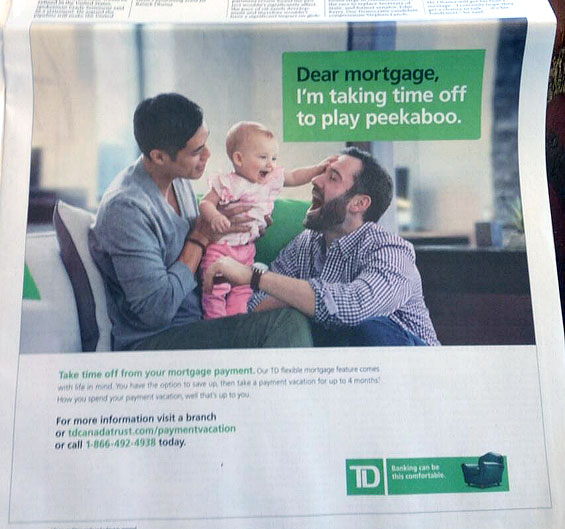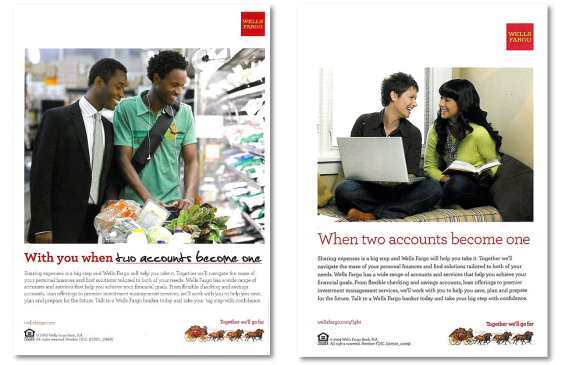Sometime in the mid 90s, retail banks and credit unions started to look at the market for gays, lesbians, bisexuals and transgender individuals (more commonly referred to as the “LGBT market”). As societal anxieties towards the LGBT community eased, so did financial marketers’ concerns about possibly targeting this audience.
It’s not a small, insignificant market either. Today, at least 8 million adults in the U.S. identify themselves as gay, lesbian, or bisexual, according to a study by the Williams Institute. Combined with 700,000 or so transgender Americans, that means nearly 4% of the U.S. population is LGBT. The research showed that slightly more people identify themselves as bisexual (1.8%) than as lesbian or gay (1.7%), and women are more likely than men to identify as bisexual.
The world’s financial institutions are becoming increasingly aware that LGBT customers represent a previously underserved yet financially significant segment. With fewer children in gay households, higher disposable incomes, and greater spending on everything (including financial products), it’s no wonder banks and credit unions are scratching their heads wondering if and how to target the LGBT community.

Are You Ready for a Digital Transformation?
Unlock the potential of your financial institution's digital future with Arriba Advisors. Chart a course for growth, value and superior customer experiences.

Move the Needle from Attrition to Acquisition
Vericast’s 2024 Financial TrendWatch explores seven of today’s most critical financial services trends to provide a complete view of the current loyalty landscape.
Read More about Move the Needle from Attrition to Acquisition
A Mass Market Strategy of Inclusion
Lloyds Banking Group ran their first gay ad in 2010, featuring a gay couple buying their dream home. The bank said the ads were part of a new equality initiative, which was to include a “rainbow network” for gay employees of the bank.
 “Lesbian and gay customers are an important part of the Lloyds TSB brand vision and these ads reflect that,” explains Eva Eisenschimmel, Group Marketing Director for Lloyds, (who identifies herself as straight). “We do now have evidence that lesbian and gay couples expect to be reflected in commercial marketing and advertising.”
“Lesbian and gay customers are an important part of the Lloyds TSB brand vision and these ads reflect that,” explains Eva Eisenschimmel, Group Marketing Director for Lloyds, (who identifies herself as straight). “We do now have evidence that lesbian and gay couples expect to be reflected in commercial marketing and advertising.”
So Lloyds started feathering LGBT couples into its marketing. They ran a TV commercial for Lloyds TSB in late 2012 where they snuck a gay couple taking their pet hedgehogs for a walk on a Segway. Lloyds has also included a gay male couple in a campaign for Halifax, one of their sub-brands.
When asked if this approach helps the bank break out of the mold of ‘pale, male and stale’ banking, Eisenschimmel offers this insightful reply: “If they do, that’s great but that’s not our rationale for doing it. We just want to be, as any big brand or business should be, inclusive.”
That’s a point mass marketers should be keen to remember. If you are a small, focused, niche financial institution, then perhaps there’s no real reason to deliberately pursue the LGBT crowd. But as a bank or credit union targeting the mass market, you need — almost by default — to have a “brand of inclusion.” The strategy isn’t necessarily to make gays and lesbians feel welcome; it’s to make everyone feel welcome.
Read More: LGBT Investors Feel Confident, Positive About Retirement
“A lot of the criticism banks have received in recent times is of appearing out of touch with modern living,” Eisenschimmel adds.
Like many financial institutions, Lloyds has found it easier to depict gay male couples than lesbians.
“I’ve challenged my team to come up with an ad with two women and I have been very overt about that in the last six months,” Eisenschimmel said in an interview with the Gay Star News. “I would say we are really determined to do that but haven’t found the way to do that yet. But we will, give us a couple more months and it’ll happen.”
TD Bank: Flamboyant, Yet Also Serious
 Many banks have been criticized for a perceived lack of sincerity and/or commitment to the LGBT community — “gaywashing” or “pinkwashing,” if you will. Good luck making that argument against TD Bank. They don’t just put lipstick on the piggybank, as it were. They are all-in, both within the organization culturally and outside with consumers.
Many banks have been criticized for a perceived lack of sincerity and/or commitment to the LGBT community — “gaywashing” or “pinkwashing,” if you will. Good luck making that argument against TD Bank. They don’t just put lipstick on the piggybank, as it were. They are all-in, both within the organization culturally and outside with consumers.
TD started collecting data on the LGBT segment in 2007 in order to position themselves as the niche community’s “bank of choice.”
“TD views this community as an important part of its customer base,” the bank explains.
According to TD’s “diversity strategy,” the bank will be focusing more time and money to appeal to the homosexual community.
TD exported this gay-friendly philosophy across the border when it jumped into the American market back in 2008. Skip ahead to 2013, and TD has placed ads showing two men holding hands on a beach, two women holding hands strolling along a beach, and a male couple cuddling on a couch — all in mainstream newspapers and magazines across North America, much to the moral dismay of groups on the right.
But nothing seems to deter TD in its support for the LGBT market. Indeed the bank is about as flamboyant as a corporate marketer can get.
TD sponsors dozens of gay pride parades in both the U.S. and Canada, and even have one named after them: the “TD Canada Trust Pride Parade” in Edmonton. And the floats they put in these parades are outrageous.
Some people will certainly think the manner in which TD is targeting LGBTs crosses the line. But therein lies the inescapable reality of target marketing: what might play well with the niche audience might also alienate others. It’s a decision with consequences marketers have to carefully weigh.
TD Bank does a lot of very serious work in the LGBT space too. Most notably, they created a powerfully poignant and touching anti-bullying video for the “It Gets Getter” public service competition.
Wells Fargo sponsored its first LGBT Pride event in San Francisco in 1992, but really started concentrating on targeting the gay market around 2001. By 2011, the bank participated in 40 separate LGBT Pride parades and festivals, although there approach is nowhere near as racy as what TD Bank does — their parade representatives don modest blue jeans, cowboy boots and do the two-step.
Damned If You Do, Damned If You Don’t?
In many respects, financial marketers find themselves in a Catch 22. If they don’t specifically cater to the LGBT audience, they can be criticized as insensitive or possibly even worse… discriminatory. But when financial marketers include gay characters in their advertising campaigns, they walk a razor’s edge with offensive stereotypes that may undermine the inclusionary message they are trying to send.
Case in point: Westpac. They ran a TV commercial featuring gay male partners (business or personal?) who moan about late payments and clients’ typical excuses. Gay rights activists complained that the ad used “gay stereotypes.” To paraphrase, they found the ad just too swishy. So they filed a formal grievance with Australia’s Ad Standards Board who initiated a formal review.
Regulators ruled that the men “are presented in a manner which, although somewhat stereotypically effeminate, focuses on their frustrations as business owners and is not negative.”
Reality Check: Advertisers have been using stereotypes forever; that’s what advertisers (and comedians) do, whether it be “blue collar workers,” “soccer moms” or “pierced-and-tattooed slacker delivery guys.” What American dad isn’t tired of being depicted in ads as the lazy, incapable buffoon who does nothing more than sleep on the sofa all weekend?

Send the Right Offers to the Right Consumers
Achieve a better return on your marketing investment. Leverage behavioral data and analytics to target the right customers with the best possible offers.
Read More about Send the Right Offers to the Right Consumers

Navigating the Role of AI in Financial Institutions
83% of FI leaders agree investing in AI is essential for 2024 but how you leverage AI is instrumental in success and meeting customer expectations.
Read More about Navigating the Role of AI in Financial Institutions
In San Francisco, It’s Business As Usual
San Francisco Fire Credit Union has included the term “partner” on its membership and loan applications for so long, erstwhile President/CEO Diana Dykstra doesn’t remember for sure when she added it. Dykstra, who is now president of the California & Nevada Credit Union League, guesses it was sometime in the early to mid-1990s, around the time the credit union also began providing insurance coverage to the domestic partners of its employees.
Dykstra, who grew up in the Bay Area, said because San Francisco has been on the forefront of gay rights for so long, ensuring quality service for gay members is part of everyday business.
“They’re productive human beings, and what they do in their private life is not relevant to serving their financial needs,” she says with a hint of indignation.
Embracing Gay Culture Inside the Organization
When Credit Suisse conducted a study on the subject, they found that nearly 1 in 9 individuals working in the banking, finance and insurance sector identifies themselves as gay. In response, Credit Suisse decided to spin off some advisors who were openly gay into a new division targeting LGBT consumers with traditional banking services and help with the financial aspects of adoption and civil partnerships.
“Clients with us have no need to explain their lifestyles or — as we know happens in some cases — almost feel the need to justify the way they choose to live their lives,” explains Stephen Connolly, head of the Credit Suisse service
Back in January 2002, Barclays launched the Spectrum Network as a support and networking group for the bank’s LGBT employees (and anyone else in the organization interested in this area).
In 2012, the Spectrum Network launched its own mobile app to help the team keep up with goings on and one another. The British banks’ gay workers use it to access details of news and upcoming events, and incorporates Spectrum’s social media presence on Facebook and Twitter (786 followers).
On its website, Barclays specifically calls out sexual orientation as one of the diversity issues the bank vigorously defends. But this has landed the bank in some hot water. You see, Barclays is one of the biggest banks in Uganda, a country that introduced an anti-homosexuality bill (often called the “Kill the Gays Bill”). The worldwide LGBT community rallied in protest, urging Barclays to condemn the bill or even pull out of Uganda completely.
The situation serves to prove that targeting niche segments is not without risk. You cannot pay marketing lip service to a group of people who are deeply passionate about their cause. If you say you support Cause X, then you better mean it. You had better be prepared for your advertising, your products and your decisions to be scrutinized at a level you will never experience when marketing to Jane Doe and Joe Average. Niche communities are stuffed with rabid watchdogs who are all to ready to drag you into the virtual town square for a severe PR beating if you stray off course. It’s much safer and smarter to walk the talk, or drink the Koolaid (whichever cliché you prefer).












